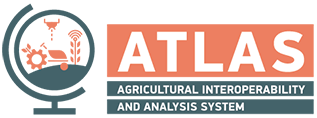
The ATLAS project is running through its second year of implementation
and solid progress ![]() has by now been achieved
has by now been achieved ![]()
 The ATLAS high-level architecture has been defined. Based on this architecture definition the implementation of a first productive version of the ATLAS Service Registry, the service access management, and the ATLAS Participant Portal have been delivered. Initial service templates for selected use cases have been designed and some have been implemented.
The ATLAS high-level architecture has been defined. Based on this architecture definition the implementation of a first productive version of the ATLAS Service Registry, the service access management, and the ATLAS Participant Portal have been delivered. Initial service templates for selected use cases have been designed and some have been implemented.
 In the frames of the Crop Monitoring Data Collection Services leaf disease patterns through ML/DL approaches were acquired. The irrigation-oriented services are ready to be tested in the upcoming season whilst the retrieval of satellite-derived growing degree days was validated against three ground truth data from land. Additionally, the Farmbot specification and design for the Vehicle Fleet Navigation Service is ready for manufacturing and the software systems are ready for initial tests on the Farmbot and the CNR wheeled robotic platform. Finally, the Livestock monitoring services are deployed and integrated into the ATLAS interoperability network.
In the frames of the Crop Monitoring Data Collection Services leaf disease patterns through ML/DL approaches were acquired. The irrigation-oriented services are ready to be tested in the upcoming season whilst the retrieval of satellite-derived growing degree days was validated against three ground truth data from land. Additionally, the Farmbot specification and design for the Vehicle Fleet Navigation Service is ready for manufacturing and the software systems are ready for initial tests on the Farmbot and the CNR wheeled robotic platform. Finally, the Livestock monitoring services are deployed and integrated into the ATLAS interoperability network.
 Good progress has also been made towards the interconnection of sensors and machines via ISOBUS and wireless communication and the development of an integrated sensor system to be used within the ATLAS pilots. In particular, the technical requirements for the On-Board processing computer and multispectral sensor box were derived and analysed resulting in the definition of specifications, which were validated through a set of feasibility studies. This has resulted in the successful selection of a suitable edge-computing device and sensors for the Multi-Sensor System as well as in the construction of a three-point mounting structure to be placed at the front of the tractor. In addition, a new High-Speed ISOBUS functionality for fast exchange of video data was demonstrated through a proof-of-concept.
Good progress has also been made towards the interconnection of sensors and machines via ISOBUS and wireless communication and the development of an integrated sensor system to be used within the ATLAS pilots. In particular, the technical requirements for the On-Board processing computer and multispectral sensor box were derived and analysed resulting in the definition of specifications, which were validated through a set of feasibility studies. This has resulted in the successful selection of a suitable edge-computing device and sensors for the Multi-Sensor System as well as in the construction of a three-point mounting structure to be placed at the front of the tractor. In addition, a new High-Speed ISOBUS functionality for fast exchange of video data was demonstrated through a proof-of-concept.
 Regarding Knowledge Exchange and Decision Support within the ATLAS end-user requirements assessment for knowledge and data exchange between different industry user requirements and relevant use-cases have been collected, whilst a first version of the data acquisition and analysis services, have been compiled. The Learning Decision support services have initiated a first scrutinization of the current IoT landscape, and more specifically of the formation of 4d data space based upon which cognitive fusion will be deployed to derive the spatiotemporal context of crop and livestock status.
Regarding Knowledge Exchange and Decision Support within the ATLAS end-user requirements assessment for knowledge and data exchange between different industry user requirements and relevant use-cases have been collected, whilst a first version of the data acquisition and analysis services, have been compiled. The Learning Decision support services have initiated a first scrutinization of the current IoT landscape, and more specifically of the formation of 4d data space based upon which cognitive fusion will be deployed to derive the spatiotemporal context of crop and livestock status.
Agricultural modelling services have resulted in the identification of all the sensitivity factors affecting crop production and drafted the first blueprints of crop-specific (cotton, maize, sunflower, wheat, barley, soya) deep learning yield estimation algorithms. Lastly, regarding the Data exchange service, an initial conceptual design of the potential characteristics and requirements has been carried out.
 In relevance to establishing the pilots and building a sustainable Ecosystem, farmers and partners have completed the first installations with equipment and are ready to perform the needed tests and comparisons, despite some delays that were encountered due to the COVID-19 pandemic. Standardization and Business Sustainability over this period have laid the foundations for understanding the challenges of data interoperability as these are faced by various technology provider groups (namely machine and sensor manufacturers) and developed an early, yet concrete, exploitation plan for all ATLAS results to safeguard the sustainability of the ATLAS results beyond the project’s timeline.
In relevance to establishing the pilots and building a sustainable Ecosystem, farmers and partners have completed the first installations with equipment and are ready to perform the needed tests and comparisons, despite some delays that were encountered due to the COVID-19 pandemic. Standardization and Business Sustainability over this period have laid the foundations for understanding the challenges of data interoperability as these are faced by various technology provider groups (namely machine and sensor manufacturers) and developed an early, yet concrete, exploitation plan for all ATLAS results to safeguard the sustainability of the ATLAS results beyond the project’s timeline.


